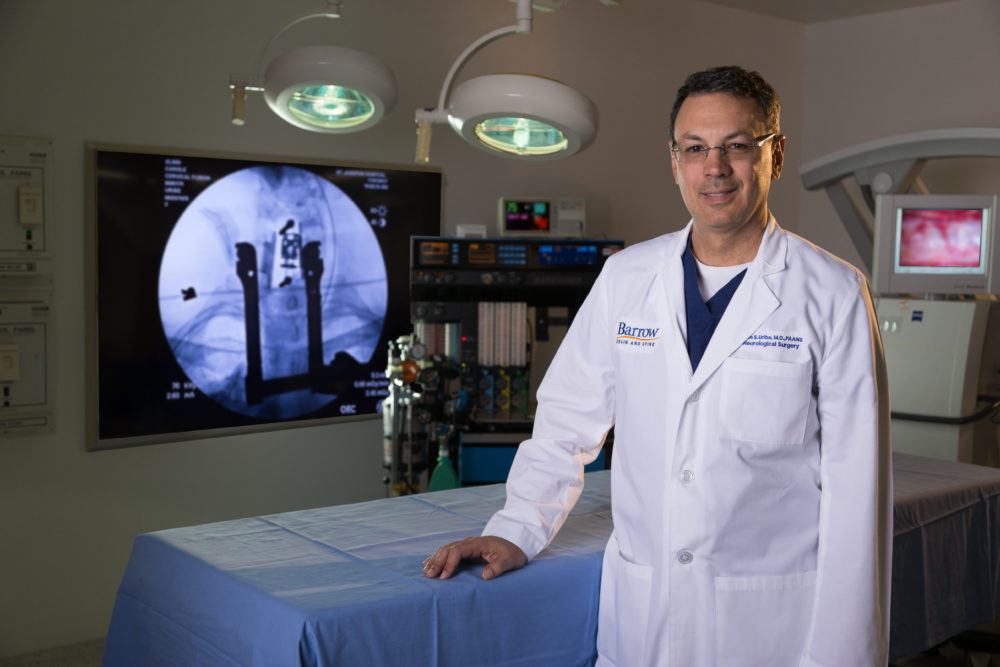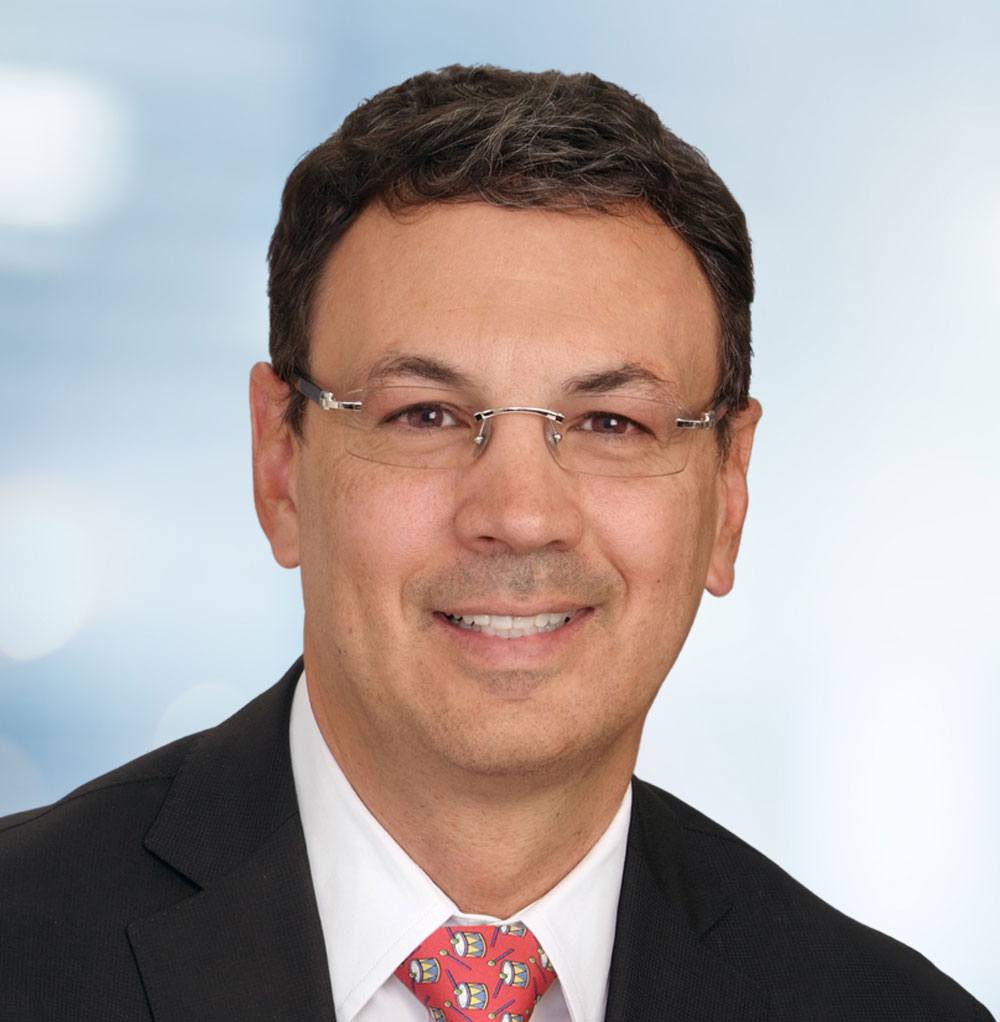
Thoracic Disc Herniation Surgery: Challenges and Advancements
Numbness or weakness in the legs, difficulty walking, and loss of bowel or bladder function are some of the “red flag signs” neurosurgeon Dr. Juan Uribe looks for when evaluating someone with thoracic disc herniation.
“These are early signs of significant compression of the spinal cord telling us that this patient has imminent risk of paralysis,” he said.
Dr. Uribe, Chief of the Division of Spinal Disorders and Vice Chair of Neurosurgery at Barrow Neurological Institute, says many spine surgeons are wary of treating thoracic disc herniation with surgery. He’ll only perform the procedure after careful evaluation.
What is disc herniation?
Disc herniation is a spinal condition in which the soft center of an intervertebral disc pushes through a tear in the outer layer of the disc and into the area around the spine, sometimes putting pressure on the spinal cord or the nerves connecting to it.
Intervertebral discs separate the bones of the spine, called vertebrae, acting as shock absorbers and enabling movement. These discs can tear due to degeneration, injury, or a combination of both. The protruding disc fragment can put pressure on the spinal cord, causing pain or dysfunction.
Herniated discs are common and can occur in any part of the spine, but they’re most frequently seen in the lumbar spine—the lower back. The thoracic region, or the mid-back, is the least mobile and therefore the least susceptible to disc herniation.
Herniated discs in the thoracic region, which is the largest segment of the spinal column, account for less than 1 percent of all herniated discs. However, they may be underdiagnosed due to subtle or unspecific symptoms such as chest pain.
Some people learn they have thoracic disc herniation when they undergo imaging tests for an unrelated problem. Even though they may not have any symptoms, they may pursue surgical treatment out of fear that their condition will worsen over time—which Dr. Uribe calls the “time-bomb concept.”
“As long as they don’t have any red flags, we prefer not to do surgery because the risks and complexity of the surgery outweigh the benefits for them,” he said. “We follow them with a series of X-rays.”
Why is the thoracic spine harder to treat?
Surgery for disc herniation usually involves a discectomy, in which a spine surgeon removes the protruding disc fragment. In some cases, a degenerated disc may need to be removed entirely and the adjacent vertebrae fused together to stabilize the spine.
Surgery for thoracic disc herniation is much more complicated than surgery for a cervical or lumbar herniation. The bones that make the thoracic region more stable and less prone to disc herniation—the ribs and sternum—also make it more difficult for a surgeon to access the region. The thoracic cavity also contains vital organs such as the heart and the lungs.
Because of these obstacles, thoracic discectomy carries an increased risk for complications such as pulmonary issues and irreversible spinal cord injury. That’s why many spine surgeons don’t perform the procedure.
“Most of these patients come to me referred from other spine surgeons,” Dr. Uribe said.
Traditionally, spine surgeons performed thoracic discectomy through an anterior (front) or a posterior (back) approach. The anterior approach requires assistance from a cardiothoracic surgeon and may involve broken ribs and breathing tubes. The posterior approach requires significant muscle cutting, and the delicate spinal cord limits the surgeon’s access to the front of the spine.
Minimally Invasive Lateral Thoracic Discectomy
Because of the risks and complications associated with the anterior and posterior approaches, spine surgeons including Dr. Uribe developed a minimally invasive lateral (side) approach. They took the extreme lateral interbody fusion (XLIF) procedure used for herniation in the lumbar region and adapted it for the thoracic region.
“We kept going up the spine and found that it was actually a very good option for these patients,” Dr. Uribe said. “We found this space behind the thorax that allows us to do a more elegant approach where we follow natural spaces and corridors within the body.”
Minimally invasive approaches generally result in a shorter hospital stay, less blood loss and post-operative pain, and fewer complications.
In the lateral approach to the thoracic spine, also known as the retropleural approach, the patient lies on their side. The spine surgeon makes a small incision over the rib cage and may remove part of the rib. Specialized instruments, advanced microscopes, and navigation techniques allow the spine surgeon to work through the small incision. Neurophysiological monitoring reduces the risk of spinal cord injury during surgery.
“We found this space behind the thorax that allows us to do a more elegant approach where we follow natural spaces and corridors within the body.”
Juan Uribe, MD, Chief of the Division of Spinal Disorders at Barrow
To reach the spinal column, the spine surgeon gently moves aside the tissue that covers the lungs (the pleura). If the herniated disc is calcified, a common characteristic and an additional challenge associated with thoracic disc herniation, the spine surgeon will drill the hardened disc until it is paper-thin before removing it.
But even with the lateral approach, surgery for a thoracic disc herniation is risky and takes about six hours to complete.
Dr. Uribe performs less than two dozen of these procedures a year. He said it’s unusual to find a surgeon who does more, not only because of the challenges but also because symptomatic thoracic disc herniation is uncommon.
“It’s hard to become an expert in this procedure because you don’t have a large volume of patients,” he said.
By comparison, Dr. Uribe said he easily performs 100 lumbar disc surgeries each year.
But for the small number of thoracic disc herniation patients who do have red flag signs, Dr. Uribe is working to educate more spine surgeons from around the world on how to perform the less-invasive retropleural approach.
“Everybody should have access to this type of surgery and technology,” he said.

